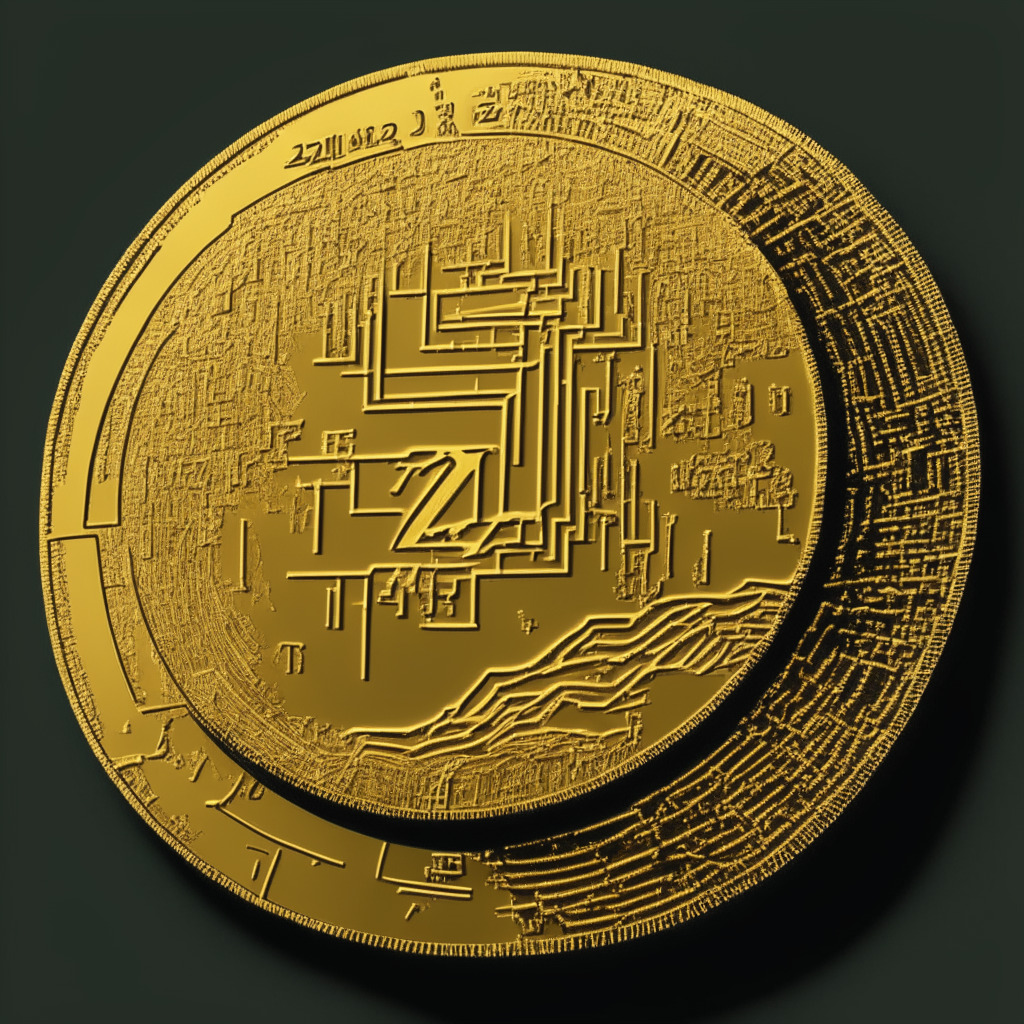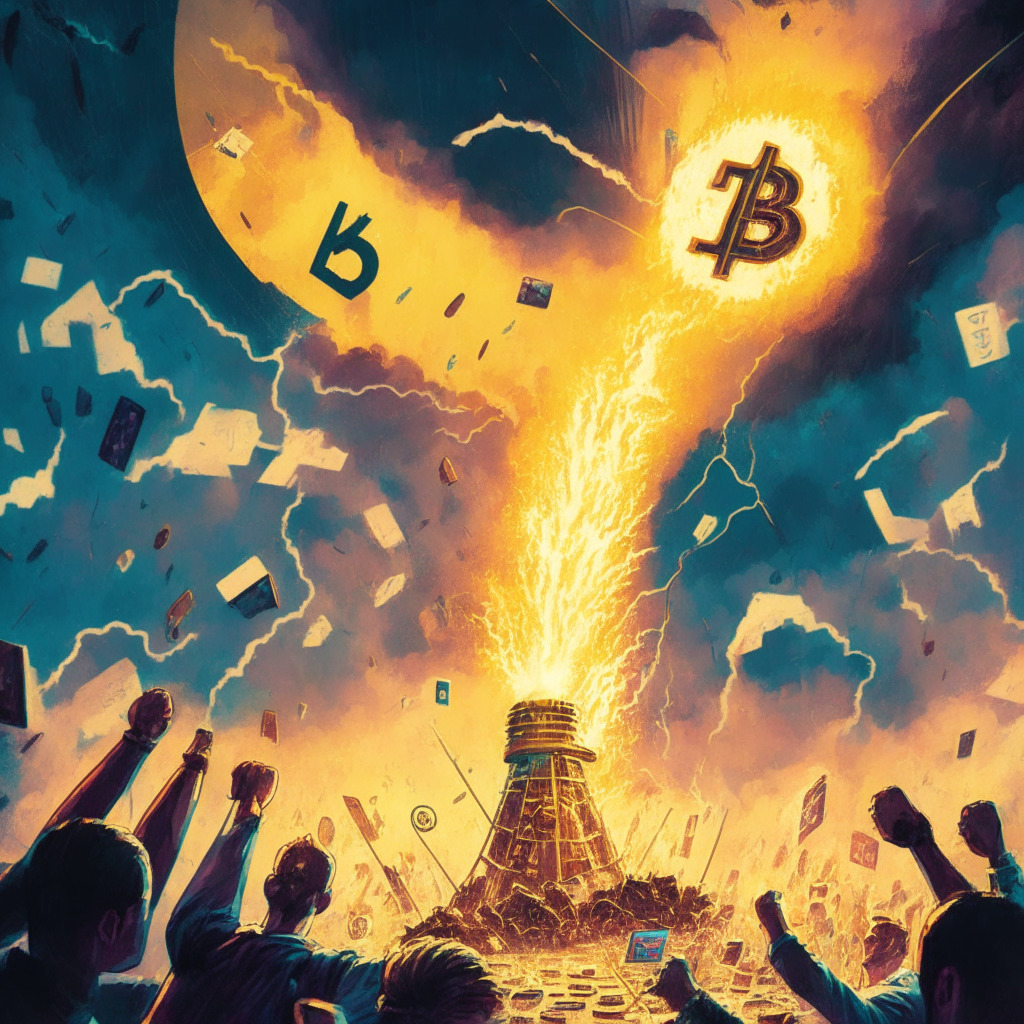“Polygon (MATIC) faces potential downward spiral following a 6% drop and the exit of co-founder Jaynti Kanani. Meanwhile, Meme Kombat, a new meme coin with an innovative stake-to-mine system, disrupts the crypto field, signaling the adaptiveness typical of the evolving digital economy.”
Search Results for: EAK Digital
Unwrapping the Saga of Alameda’s USDT Mints & Zimbabwe’s Gold-Backed ZiG Tokens
“Alameda Research has minted over $38 billion in Tether (USDT) tokens in 2021, indicating that the total value of USDT creation surpasses Alameda’s total assets. The inner workings of this process involve benefiting from trade value discrepancies and ensuring USDT’s dollar peg stability. However, this raises ethical concerns for industry watchers.”
Pioneering a New Frontier: China Daily’s Venture into the Metaverse and NFTs
“China Daily, an English-language newspaper giant, has announced a $390,000 budget for creating a metaverse and non-fungible tokens (NFT) platform. This groundbreaking initiative, soliciting offers from both domestic and international blockchain firms, highlights the escalating global interest in NFTs and the metaverse, potentially morphing the future of journalism and content creation.”
Binance Scam in Hong Kong: A $450K Lesson in Crypto-Security Vulnerabilities
“Despite the security prowess that blockchain technology is renowned for, a recent wave of cyber-crime caused 11 Binance users in Hong Kong to lose over $446k. This demonstrates the ongoing struggle between the technology’s versatility and inherent vulnerabilities, highlighting shortcomings in existing security frameworks and the urgent need for comprehensive solutions.”
Navigating the Waves of Crypto Security: Lessons from the 3Commas Hacks
“The quest for impermeable security in the crypto world is ongoing. Notable incidents with 3Commas highlight the value of enabling two-factor authentication and changing passwords regularly. Both firms and users must ensure safety of digital assets through constant vigilance and proactive measures.”
Repercussions of the Macroeconomic Landscape on the Cryptocurrency Sphere: Risks and Opportunities
The escalating situation between Israel and Palestine has impacted crypto values, with Ether and Bitcoin experiencing significant declines. An anticipated shift of attention towards economic indicators could further affect these values. Concerns about these risks have led traders towards minor digital currencies and meme coins, albeit extremely risky endeavors. Crypto remains a high-risk asset, and investors must remember the potential for loss.
Geopolitical Tensions: Unpredictable Influence on Financial Assets and the Crypto Market
“The escalating tensions between Israel and Hamas are affecting global financial markets, causing a decline in emerging stocks and cryptocurrencies, and a surprising uptick in traditional safe havens like oil and precious metals. Amid this turmoil, global economies are grappling with high oil prices and inflationary pressure, while the long-term effects are yet to be seen.”
The Rollercoaster Ride of ApeCoin and the Surging Interests in Upcoming Launchpad XYZ
“ApeCoin (APE) experiences a nearly 20% drop, coinciding with a surge in trading volumes. Despite financial fluctuation, upcoming AI platform Launchpad XYZ is gaining presale interest. Promising analytics and trading signals, along with an NFT marketplace, decentralized exchange, and integrated digital wallet, it aims to be the go-to portal for blockchain requirements.”
MoonPay’s Cryptocurrency Swapping: A Simplified Approach with Potential Risks and Future Promise
“MoonPay has launched a feature for users to swap one cryptocurrency for another, elevating their consumer-focused application. Despite facing allegations of artificially inflating NFTs, major firms are expanding their crypto portfolios mirroring MoonPay’s approach. Adapting regulatory framework, business strategy, and observing ethical issues are key to this emerging tech’s growth.”
Swinging DOGE Trends: A Dance between Rebounds and Depreciation, and a Look at Rising TG.Casino
Dogecoin (DOGE) has seen a 14% dip in prices since the start of the year, with its 30-day EMA lingering beneath its 200-day average, indicating a period of decline. Although its community remains hopeful for integration into cryptocurrency payment by a former Twitter-owned company, speculation about future spikes in value remains uncertain. Meanwhile, potential investors are exploring other coins with tangible use-cases, such as TG.Casino’s native TGC token.
Security Storm Hits Stars Arena: Analyzing the $2.85 Million Avalanche Blockchain Breach
Stars Arena, a platform powered by Avalanche’s Contract Chain, suffered a major security breach leading hackers to successfully takeaway 266,103 AVAX. The aftermath caused the AVAX price to tremble, dropping from $11.56 to $10.78. Securing the platform’s functionality and user funds is now their primary focus.
From Micro-Cents to Magnates: Terra Luna Classic (LUNC) and TG.Casino’s (TGC) Potential Uplift
“In this digital assets world, Terra Luna Classic’s LUNC stands out with its current price of $0.00006 and potential leap to $3 in two years. Its symmetrical triangle formation and possible bearish break hint at market volatility, making resistance and support levels important to monitor. In contrast, new altcoin TG.Casino’s TGC showcases utility and staking capabilities in a decentralized casino platform.”
Coercing Cyber Criminals: The Dilemma of Crypto Bounty for Stolen Assets Recovery
“In the evolving blockchain technology landscape, securing crypto platforms against cyber breaches remains a pressing task. Instances like HTX using bounties to recover stolen funds hint at innovative strategies, but also present a dangerous precedent. Persistent advancements in blockchain security are therefore essential.”
The Great Bitcoin Tug-of-War: Will It Breach the $28,500 Threshold or Retreat?
Bitcoin displays impressive tenacity, standing at $27,973 with market capitalization of $545.69 billion. From a technical perspective, crucial price points include resistance at $28,350 and support at $26,630. While the Relative Strength Index suggests slight bearish sentiment, the Bitcoin forecast remains predominantly bullish, provided it maintains above the $27,500 mark. However, the crypto market’s volatility calls for careful strategy adjustment.
Ethereum’s Struggle with $2000: Technical Hurdles, Economic Factors, and Potential Rebound
“Ethereum’s native token, Ether, is struggling to surpass the $2000 mark. It faces technical levels resistance linked to the U.S. dollar strength and Bitcoin’s market momentum. Ethereum ecosystem’s total-value-locked (TVL) decrease, and falling trends in active wallets and Non-Fungible Tokens (NFTs) volumes add to the challenge.”
Decentralized Tug of War: NFTs, DeFi, and the Struggle between Expansion and Focus
In the world of decentralised finance and NFTs, industry players grapple with balancing expansion and focus, infrastructure scalability, and merging traditional and digital markets. Mythos Chain, Yuga Labs and Starbucks’ activities, among others, embody these dilemmas.
Taiwan’s Imminent Crypto Regulatory Bill: Expectations, Challenges, and Impacts on Local Exchanges
“Taiwanese legislators are set to introduce the country’s first cryptocurrency regulatory bill in November 2023, aimed at overseeing cryptocurrency trading and related activities. The law is intended to prevent ‘regulatory arbitrage’ and protect investors from the challenges posed by rising foreign crypto operations.”
Blockchain and DeFi Brilliance or Bust: Navigating through Security Concerns and Revolutionary Potential
“Blockchain’s role in decentralized finance (DeFi) experienced a record-breaking incident in September 2023, with over $300 million lost to exploitations. Despite security challenges, DeFi’s potential continues to attract diverse industries, but is also pressured by global regulations and business demands.”
Bitcoin Fluctuations and the Market Response to U.S. Job Data: A Seismic Dance of Crypto and Economy
The crypto market’s recent volatility is linked to the U.S. jobs data and potential interest rate hike by the Federal Reserve. Bitcoin and other cryptos reacted disruptively, with rapid price shifts influenced by macroeconomic indicators. It highlights the necessity of a nuanced understanding of wider financial systems for crypto enthusiasts, as unwarranted shocks from global markets test the resilience of digital assets.
Komainu’s Milestone Regulatory Approval: A Victory for Progress or Threat to Cryptocurrency Essence?
Komainu, a venture co-founded by CoinShares, Ledger, and Japanese Nomura, has gained substantial regulatory approval in the U.K. as a custodian wallet provider. While this development brings crypto custody services to the U.K. and contributes to the country’s fintech landscape, it also raises concerns about individual privacy rights and the balance between industry regulation and the decentralized nature of cryptocurrencies.
The Ripple Effects: Collapse of 3AC, Cryptocurrency Investment Risks and Future Regulation
This article discusses the dramatic crash of Three Arrows Capital, a company that previously handled over $10 billion in digital assets, and the resulting financial aftermath. The event thrusts focus on the need for better regulation and safeguards in the crypto industry.
KYC Regulations in Cryptocurrency: Balancing Compliance with Crypto Ideals
“OKX executive, Lennix Lai, emphasized the role KYC plays in raising compliance standards in cryptocurrency exchanges. Though necessary for safeguarding customer interests, stricter compliance standards may erode cryptocurrency’s core ideologies of decentralization, privacy, and financial sovereignty, placing potential burden on startups.”
Zero-Knowledge Tech Fueled W-Pay: A Revolution in Secure Crypto Transactions
“Wirex, a global digital payment platform, introduces W-Pay, an App Chain powered by Zero-Knowledge technology. Aimed at enhancing connections between DApps, non-custodial wallets, and traditional payment systems, it offers swift, secure transactions and total fund control. The Ethereum Virtual Machine compatibility ensures diverse functionalities and promotes crypto ecosystem interoperability.”
Crypto Chaos: Uncovering the Dark Side of Estonia’s Flourishing Blockchain Sector
An international investigation has uncovered serious financial fraud and money laundering in Estonia’s crypto sector, with over €1 billion being scammed or laundered. Massive infiltration of crypto entities, despite tightened regulations, reveals weak links in the financial chain, highlighting the urgency of navigational caution for crypto investors.
Blockchain Boundaries: Telecom Titan NTT Docomo Joins Forces with Crypto Exchange Monex
“In a recent breakthrough, NTT Docomo and crypto exchange Monex announced a strategic partnership to develop new asset formation services, aiming to expand individual wealth formation in Japan. The alliance shows Monex’s increasing footprint in the crypto world, indicating potential domestic and international expansion.”
Unraveling the Web of Controversy: The Revealing Sam Bankman-Fried Case and Crypto Regulation Dilemma
Sam Bankman-Fried, founder of the now-disgraced crypto exchange FTX, is involved in a scandal that’s sending shockwaves through the cryptocurrency world. Allegations suggest mounting debt and troubling financial practices, underscoring the need for robust regulation within the crypto environment.
Downtrend in Crypto Trading Volumes: Binance’s Challenge of Regulatory Scrutiny and Declining Market Shares
Centralized exchanges, including leading platform Binance, have seen a significant downturn in trading volumes over the last three months, with total trading volume dipping to $1.67 trillion, about 20.3% drop. This declining trend, together with increased regulatory scrutiny, has presented challenges, but also opportunities for exchanges like OKX, Bybit, and Bitget to grow their market share.
Navigating Bitcoin’s Tough Road to $30,000: Exploring the Underlying Challenges
Bitcoin’s struggle to surpass $28.5K is attributed to factors such as failed launch of Ether futures ETFs, US Federal Reserve’s economic concern, a dip in Bitcoin’s core trading metrics, and dwindling faith in the prospect of a spot Bitcoin ETF. The path towards $30,000 appears uncertain.
South Korea’s Central Bank Tests Ground for Potential Wholesale CBDC Implementation: Progress or Peril?
South Korea’s central bank is collaborating with the Bank for International Settlements for a test run on wholesale central bank digital currencies (CBDCs) seeking to assess the feasibility of setting South Korea’s future monetary framework based on CBDCs. The test project focuses on the CBDC’s efficiency as a settlement asset and its programmability potential.
Global Crypto Investment: A Path to Improved Living or Regulatory Nightmare?
Crypto users worldwide are increasingly investing in digital currencies in hopes of improving their lifestyle. Survey results indicate varying motivations across different demographics and locations: from funding children’s education to defying trading bans using VPN services. However, tightening regulations and price depreciation have caused a stagnation in some areas. Despite these hurdles, an optimistic outlook remains, as digital assets continue to present a potentially profitable avenue for individual investors.
Friend.tech’s Decentralized Security Update: Enhancing User Access or Making Way for Advanced Threats?
Friend.tech, a decentralized social network, has updated user login settings following a series of SIM-swap security breaches resulting in a loss of over 100 ETH. Despite enhancements to individual account control, users have voiced concerns about issues like lack of two-factor authentication and persistent sessions on multiple devices.
Wirex’s W-Pay: Future DeFi Gamechanger or Just Another Crypto Wild Card?
Wirex’s new service, W-Pay, introduces a non-custodial crypto debit card service leveraging Zero-Knowledge (ZK) proofs-based technology. This service offers a new way of interacting with cryptocurrencies daily, promising swift, secure transactions, and sole control over funds. However, ongoing challenges with partnership dependencies may pose questions about the technology’s reliability.































